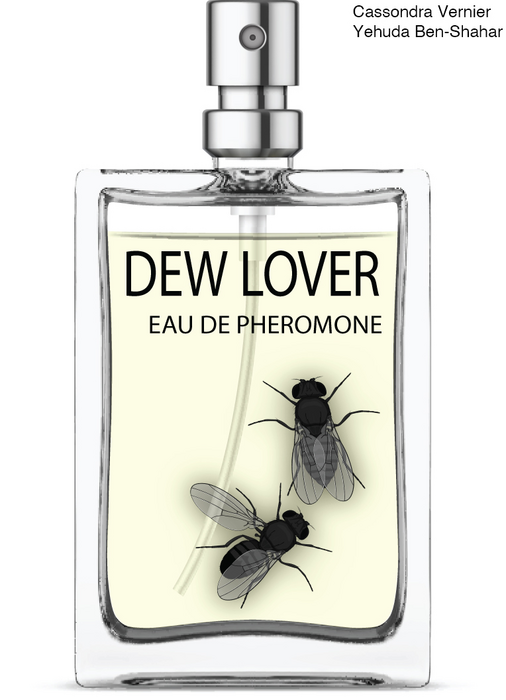It’s almost Valentine’s Day, and love is in the air. Or in the waxy coating on your skin, if you are a vinegar fly. That’s where flies encounter pheromones that play an important role in regulating sexual attraction.

Credit: Digital art by Yehuda Ben-Shahar, Washington University in St. Louis
It’s almost Valentine’s Day, and love is in the air. Or in the waxy coating on your skin, if you are a vinegar fly. That’s where flies encounter pheromones that play an important role in regulating sexual attraction.
Flies use pheromones to ensure that they court and mate with members of the same species. As new fly species split off from a common ancestor, but continue to share the same environment, they need a way to rapidly diversify their pheromones to suppress inter-species mating. When members of two related species stop finding each other attractive, this helps prevent interbreeding.
But it’s more complicated than “she loves me, she loves me not.“
Because the perception and production of pheromones are mediated by different tissues and cellular pathways, evolving new mating pheromones requires a coordinated evolution of both the genes responsible for sensing the pheromones as well as the genes that produce them.
A new study in iScience led by Yehuda Ben-Shahar at Washington University in St. Louis identifies a link between the genetic instructions for the production and perception of sex pheromones. The research was conducted in collaboration with Jocelyn Millar from the University of California, Riverside.
Researchers reported that a single protein called Gr8a is expressed in different organs in male and female flies and appears to play an inhibitory role in mating decision-making. The findings point to one of the ways that flies could put up behavioral barriers to protect against mating with the wrong kind of partner.
“Mating pheromones often show rapid evolution,” said Ben-Shahar, a professor of biology in Arts & Sciences. “Because pheromonal communication requires a very robust and specific structural recognition of chemicals used as pheromones by the proteins that bind them in sensory neurons (chemoreceptors), it means that major molecular changes in either the receptor or the pheromone would reduce sexual attraction between males and females.”
Ben-Shahar and his team found that Gr8a was expressed in tissues in fly mouthparts, including the proboscis, as well as in taste neurons in the forelegs of both males and females. They also found Gr8a in cells in the abdomens of males. This was important because it provided Ben-Shahar and his team the first hint that a gene that had been previously identified as a sensory chemoreceptor must also have non-neuronal functions.
“Our findings provide a relatively simple molecular explanation for how signal production and perception are tied together in vinegar flies,” Ben-Shahar said. “A single pleiotropic protein can function as both a receptor for pheromones in sensory neurons, as well as contribute to their production in the pheromone-producing cells (oenocytes) of males, by way of a less-understood process.”
In one of the experiments that Ben-Shahar and his team conducted, the scientists took flies that were mutant for the Gr8a receptor and reconstituted them using input from a different vinegar fly species. This experiment showed that introducing Gr8a from another species was enough to change the overall pheromone profile of the animal.
The scientists still have not pinpointed exactly how the chemoreceptor affects the way the signal is produced, but they do know that it causes quantitative and qualitative differences in pheromones. And even small changes in pheromones could be enough to keep closely related flies from finding each other attractive — and change their mate choice behaviors.
The question of how closely related species evolve and maintain behavioral mating barriers is one that has implications for several different basic and applied biological research fields.
“Based on what we have observed, mutations in a single gene could provide a molecular path for a pheromonal communication system to evolve while still maintaining the functional coupling between a pheromone and its receptor,” Ben-Shahar said. “Our research uncovers a potential avenue for pheromonal systems to rapidly evolve when new species arise.”
—
This work was supported by National Science Foundation grants 1322783, 1754264 and 1707221, and National Institutes of Health (NIH) grant NS089834.
Journal
iScience
DOI
10.1016/j.isci.2022.105882
Method of Research
Experimental study
Subject of Research
Animals
Article Title
A pleiotropic chemoreceptor facilitates the production and perception of mating pheromones
Article Publication Date
20-Jan-2023



